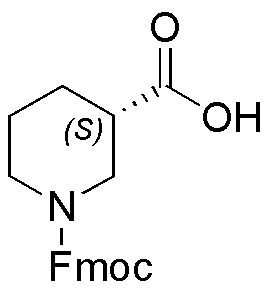Fmoc-L-nipecotic acid is widely utilized in research focused on:
- Peptide Synthesis: This compound serves as a protective group in the synthesis of peptides, allowing for the selective modification of amino acids without interfering with other functional groups. This is crucial for creating complex peptides used in pharmaceuticals.
- Drug Development: Its unique structure makes it valuable in the development of new drugs, particularly in the field of neuropharmacology, where it can be used to design compounds that target specific receptors in the brain.
- Biochemical Research: Researchers use it to study the interactions between proteins and small molecules, helping to elucidate biological pathways and mechanisms, which is essential for advancing our understanding of diseases.
- Material Science: Fmoc-L-nipecotic acid can be employed in the creation of novel materials, including hydrogels and polymers, which have applications in drug delivery systems and tissue engineering.
- Analytical Chemistry: It is used as a standard in chromatographic techniques, aiding in the accurate analysis of complex mixtures in both academic and industrial laboratories.
General Information
Properties
Safety and Regulations
Applications
Fmoc-L-nipecotic acid is widely utilized in research focused on:
- Peptide Synthesis: This compound serves as a protective group in the synthesis of peptides, allowing for the selective modification of amino acids without interfering with other functional groups. This is crucial for creating complex peptides used in pharmaceuticals.
- Drug Development: Its unique structure makes it valuable in the development of new drugs, particularly in the field of neuropharmacology, where it can be used to design compounds that target specific receptors in the brain.
- Biochemical Research: Researchers use it to study the interactions between proteins and small molecules, helping to elucidate biological pathways and mechanisms, which is essential for advancing our understanding of diseases.
- Material Science: Fmoc-L-nipecotic acid can be employed in the creation of novel materials, including hydrogels and polymers, which have applications in drug delivery systems and tissue engineering.
- Analytical Chemistry: It is used as a standard in chromatographic techniques, aiding in the accurate analysis of complex mixtures in both academic and industrial laboratories.
Documents
Safety Data Sheets (SDS)
The SDS provides comprehensive safety information on handling, storage, and disposal of the product.
Product Specification (PS)
The PS provides a comprehensive breakdown of the product’s properties, including chemical composition, physical state, purity, and storage requirements. It also details acceptable quality ranges and the product's intended applications.
Certificates of Analysis (COA)
Search for Certificates of Analysis (COA) by entering the products Lot Number. Lot and Batch Numbers can be found on a product’s label following the words ‘Lot’ or ‘Batch’.
*Catalog Number
*Lot Number
Certificates Of Origin (COO)
This COO confirms the country where the product was manufactured, and also details the materials and components used in it and whether it is derived from natural, synthetic, or other specific sources. This certificate may be required for customs, trade, and regulatory compliance.
*Catalog Number
*Lot Number
Safety Data Sheets (SDS)
The SDS provides comprehensive safety information on handling, storage, and disposal of the product.
DownloadProduct Specification (PS)
The PS provides a comprehensive breakdown of the product’s properties, including chemical composition, physical state, purity, and storage requirements. It also details acceptable quality ranges and the product's intended applications.
DownloadCertificates of Analysis (COA)
Search for Certificates of Analysis (COA) by entering the products Lot Number. Lot and Batch Numbers can be found on a product’s label following the words ‘Lot’ or ‘Batch’.
*Catalog Number
*Lot Number
Certificates Of Origin (COO)
This COO confirms the country where the product was manufactured, and also details the materials and components used in it and whether it is derived from natural, synthetic, or other specific sources. This certificate may be required for customs, trade, and regulatory compliance.


